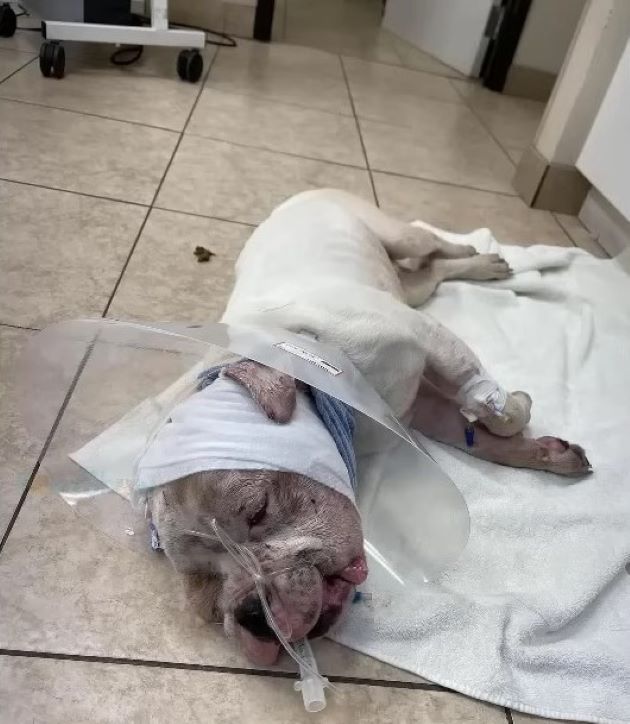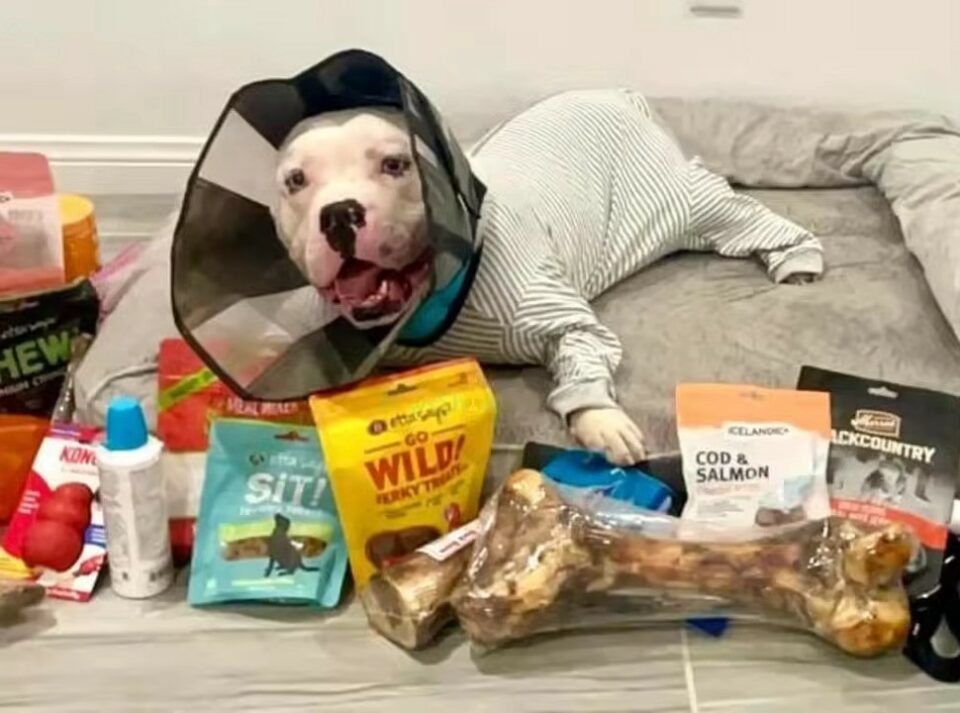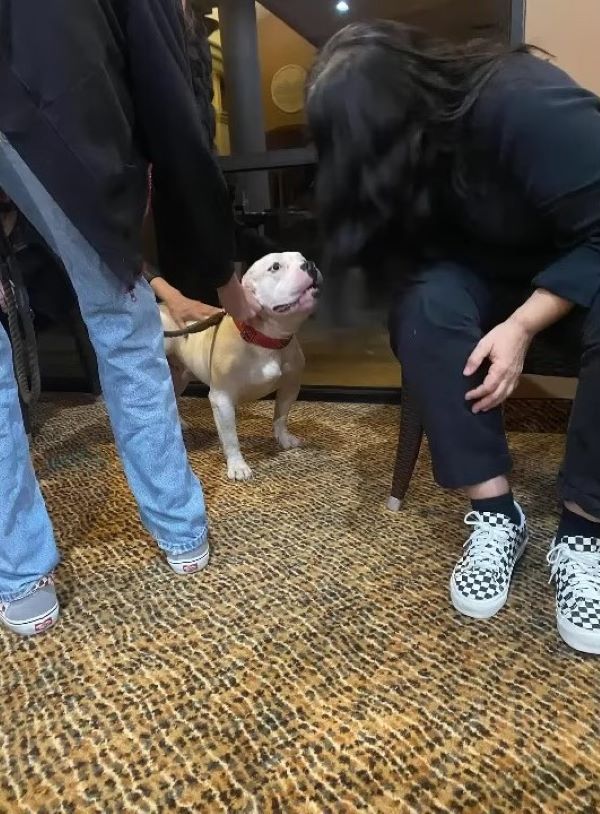Life for a typical stray dog can be very cruel and full of struggle. Many times, we just assume that the only thing they need is food to be okay.
However, what we often ignore is the fact that a lot of them likely get either abused or attacked more often than not. And, that is just horrible.
This poor pup was attacked by a pack of big dogs and suffered some serious injuries. After that, he retreated to a safe place where he rested for a bit.
Luckily, his luck would turn for the better when a rescuer noticed his misfortune and decided to intervene.
A Lucky Break

As soon as his rescuers arrived at the scene, they were shocked by his appearance. He had sustained quite a few injuries, and he was also deaf.
The man just couldn’t believe how something like this could happen to a dog this sweet, but he had no time to think about that.
He had to get him to a safe place, so he grabbed the dog, now named Hercules, and took him to a veterinarian clinic.
After receiving a checkup, they found that his ears were chewed on, and he had quite a few infections as well.

Additional problems were swelling and malnourishment as this pup likely hasn’t eaten in a very long time.
The rescuer also found that the dog had a thick chain around his neck, which meant that at some point, he was living his life in isolation and couldn’t move a lot.
After the vets were done with their tests, they focused on stabilizing the dog with IV fluids, antibiotics, and pain medication.
Hercules Was Going To Recover

Hercules was in a lot of pain, but his vets were making sure that things would improve soon enough.
They also did an X-ray to see if they could find anything else, and the results were absolutely shocking. He had a screw inside his stomach.
He must have been starving for so long that he ate it because he had nothing else. It’s just horrible to even think about what he must have been through.
Hercules will likely undergo several surgeries as they are necessary to help him be a healthy dog again.
In the meantime, he is being cared for by his amazing rescuer. His health is improving with each passing day and his mood has also changed.

He is a lot happier now that he knows there are people taking care of him and he wants to play with them all the time.
They all love him so much and are constantly taking Hercules on many new adventures. He is completely amazed by everything he sees and loves exploring new environments.
He is so friendly to everyone he meets. It’s really amazing to see just how unchanged he remained in his attitude toward humans despite being mistreated before.
It’s unusual for many dogs to recover from such a traumatic experience in the way that Hercules did. I am glad that he got the second chance.
Hercules is indeed a very special pup who deserves all the best in his life and I hope he continues living his life with the most amazing people who rescued him.
If you’ve ever witnessed your furry friend’s reaction to catnip, you might be curious about what it could do to your canine companion. The effects of catnip on dogs can be quite intriguing, and as a seasoned dog trainer, you’re always on the lookout for ways to understand your pup better. Dogs and catnip – an unexpected combination that raises many questions and piques your interest.
As you navigate the world of pet behavior and enrichment, exploring the impact of catnip on dogs adds another layer to your expertise. Observing how different animals interact with stimuli like catnip can offer valuable insights into their behaviors and preferences. With your experience in training dogs, delving into the potential effects of catnip on your four-legged friend opens up a new avenue of discovery in your journey as a dedicated dog lover.
Understanding Catnip
If you’re wondering how catnip affects dogs, it’s essential to understand its primary behavioral impact on our canine companions.
Scent Sensitivity
Dogs have a keen sense of smell, making them sensitive to scents like catnip. The aromatic compounds in catnip can trigger various reactions in dogs.
Response Variability
Not all dogs react the same way to catnip. While some may show interest or excitement, others may display indifference. This individual variability is crucial to note.
Behavioral Changes
When exposed to catnip, some dogs may exhibit behaviors similar to those of cats, such as rolling, rubbing, or increased playfulness. These responses can vary in intensity.
Duration of Effects
Unlike in cats, the effects of catnip on dogs are typically short-lived. The behaviors induced by catnip in dogs may last for a few minutes to half an hour, depending on the dog.
Safe Consumption
While catnip isn’t toxic to dogs, it’s essential to monitor their reaction. Ingesting large amounts of catnip can lead to digestive issues, so always use it in moderation.
By understanding how catnip affects dogs, you can better observe and interpret your furry friend’s behavior when exposed to this aromatic herb.
Effects of Catnip on Dogs
When it comes to dogs, catnip can have a surprising impact. Here’s what you need to know:
1. Scent Sensitivity:
Dogs have a keen sense of smell, and catnip’s aroma can be enticing to some, while others might not react at all.
2. Variable Responses:
Not all dogs respond the same way to catnip. Some may show excitement, while others may seem indifferent.
3. Behavioral Changes:
Catnip can cause behavioral changes in dogs, such as increased playfulness or relaxation. It’s essential to observe your dog’s reaction.
4. Short-Lived Effects:
Unlike cats, the effects of catnip on dogs are usually short-lived. The excitement or calmness may not last long.
5. Monitoring Consumption:
It’s crucial to moderate your dog’s exposure to catnip. Too much consumption can lead to digestive issues, so keep an eye on how much they ingest.
Understanding these effects can help you interpret your dog’s behavior better when exposed to catnip.
Safety of Catnip for Dogs
When it comes to catnip, you may wonder if it’s safe for your furry friend. Here’s what you need to know about the safety of catnip for dogs:
1. Limited Information:
There’s limited research on the effects of catnip on dogs. While catnip is known to affect cats, its impact on dogs is not fully understood. So, it’s essential to proceed with caution when introducing it to your canine companion.
2. Potential Side Effects:
Some dogs may experience mild digestive issues like vomiting or diarrhea if they ingest large amounts of catnip. Keep an eye on your dog after exposure to catnip to ensure they don’t exhibit any adverse reactions.
3. Monitor Consumption:
If you decide to give your dog catnip, monitor their consumption closely. Like any new treat or herb, it’s best to start with small amounts to gauge their reaction. If your dog shows any signs of distress, stop giving them catnip immediately.
4. Consult Your Vet:
Before giving your dog catnip, it’s advisable to consult your veterinarian. They can offer personalized advice based on your dog’s health, age, and any existing conditions. Your vet can guide you on whether catnip is suitable for your furry companion.
5. Use Responsibly:
As with any new substance, use catnip responsibly with your dog. While some dogs may enjoy the effects of catnip, others may not react positively. Always prioritize your dog’s well-being and make informed choices regarding their exposure to catnip.
Remember, your dog’s safety and comfort are the top priorities when considering introducing catnip. Keep a watchful eye, start slow, and consult your vet when in doubt.
Alternatives to Catnip for Dogs
1. Valerian Root:
If you’re looking for an alternative to catnip for your dog, valerian root might be a good option. This herb is known for its calming effects on dogs and can be given in small doses to help relax your furry friend.
2. Chamomile:
Chamomile is another natural remedy that can help soothe your dog’s nerves. You can brew a mild chamomile tea and add it to your dog’s water or food to promote relaxation.
3. Lavender:
Lavender is famous for its calming properties and can be used to create a soothing environment for your dog. You can use lavender essential oil in a diffuser or dilute it with water to create a calming spray for your dog’s bed.
4. CBD Oil:
CBD oil is gaining popularity for its potential calming effects on dogs. When choosing a CBD oil for your pup, make sure it’s specially formulated for pets and consult your vet for the appropriate dosage.
5. Interactive Toys:
Instead of using herbs or oils, interactive toys can be a great way to keep your dog engaged and mentally stimulated. Puzzle toys or treat-dispensing toys can provide hours of entertainment for your furry companion.
6. Playtime and Exercise:
Regular playtime and exercise are essential for your dog’s overall well-being. Engage in interactive games, take your dog for walks, or try out agility training to keep them happy and healthy.
7. Training and Positive Reinforcement:
Training sessions can be a mentally stimulating activity for your dog. Use positive reinforcement techniques to reinforce good behavior and create a strong bond with your pet.
Remember, every dog is unique, so it’s essential to find what works best for your furry friend when looking for alternatives to catnip. Consult your vet for advice tailored to your dog’s specific needs and preferences.
Conclusion
So, when it comes to catnip and dogs, it’s essential to approach with caution. Remember, every dog is different, so what works for one may not work for another. Consulting your vet is crucial before trying out any new remedies. Keep an eye on your furry friend’s reaction and be ready to explore alternative options like valerian root, chamomile, or interactive toys. Ultimately, your dog’s well-being and happiness are what matter most, so choose wisely and enjoy the journey of finding what brings joy to your four-legged companion.
Frequently Asked Questions
Can dogs have catnip?
Yes, dogs can have catnip, but caution is advised due to potential side effects like vomiting or diarrhea. It is recommended to consult a vet before introducing catnip to your dog.
What are alternatives to catnip for dogs?
Alternatives to catnip for dogs include valerian root, chamomile, lavender, CBD oil, interactive toys, playtime, exercise, and training with positive reinforcement. Each dog may respond differently, so it’s essential to find what works best for your furry friend.
How should I choose the best alternative for my dog?
To choose the best alternative for your dog, consider consulting a vet for tailored advice based on your dog’s individual needs and preferences. Prioritize your dog’s well-being and observe their response closely when trying out different alternatives.
[no_toc]

Hey there, I’m Janet Brooks, a dog-loving student from California. I’m all about helping pups in need, especially those without homes. Me and my awesome friends work together to give shelter and love to stray dogs. Oh, and I also write blogs about dogs to share helpful info.